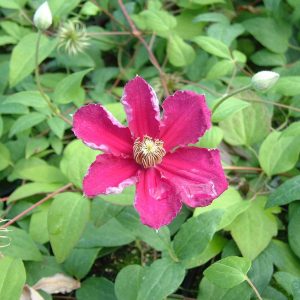Description
Viburnum burkwoodii is a popular evergreen shrub that produces an abundance of fragrant, pinkish-white flowers in spring. The plant has glossy, dark green leaves that turn reddish-purple in autumn, adding to its ornamental appeal. Viburnum burkwoodii grows to about 2-3 meters in height and spread, making it a great choice for hedges, mixed borders, or as a stand-alone specimen. It prefers well-drained soil and can tolerate a range of growing conditions, including partial shade. The plant also attracts pollinators, such as bees and butterflies, and its berries provide a valuable food source for birds.
Key Facts
- Common Name(s):Burkwood Viburnum
- Hardiness:Fully hardy
- How big will I get? Viburnum x burkwoodii can grow to a height of 2.5m and a spread of.5m.
- Did You Know That:Viburnum can have up to 4 periods of colour through the year, with up to two flushes of flowers, berries and often fiery foliage in Autumn?
Plant Calendar
A rough guide to how this plant will change through the year.
| Jan | Feb | Mar | Apr | May | June | July | Aug | Sept | Oct | Nov | Dec | |
| Flowering Time |  |
 |
||||||||||
| Foliage Colour |  |
 |
 |
 |
 |
 |
 |
 |
 |
| J | F | M | A | M | J | J | A | S | O | N | D |
 |
 |
||||||||||
 |
 |
 |
 |
 |
 |
 |
 |
 |
Care Guide

Soil Requirements
Viburnum x burkwoodii is a versatile plant and can cope with wet or drier soils, but prefers there to be decent drainage. This plant can grow in soil with a wide range of pH levels, it is not picky about the pH level of the soil.

Best Position
Viburnum x burkwoodii can handle either an exposed or a sheltered position and is a very versatile plant that can cope with full shade, partial shade, or full sun.

Maintenance
Viburnum x burkwoodii is fairly low maintenance and doesn’t require any pruning. Can be cut back hard in late Spring if desired.

Pest, Diseases and Wildlife
Viburnum x burkwoodii can have problems with aphids, it can be vulnerable to certain diseases such as leaf spot, grey moulds and root rot. It is considered to be toxic.





